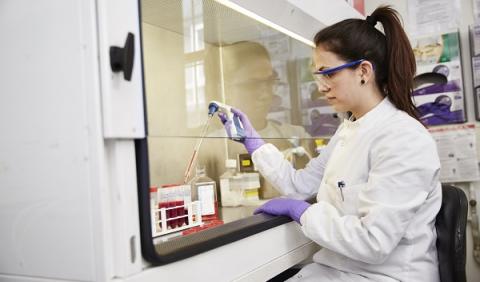With the help of our colleagues at Be The Match in the U.S., here’s the latest news from the world of stem cell transplant research.
Do haplo-identical transplants work as well as unrelated donor transplants for patients with lymphoma?
A haplo-identical transplant means that doctors use stem cells from one of your relatives whose HLA partially matches yours. Parents are always a half-match for their children and vice versa. Siblings have a one in two (50 percent) chance of being a half-match for each other. In this study, researchers looked at 917 people who had a transplant for Hodgkins or non-Hodgkins lymphoma between 2008 and 2013. Some of the patients had a transplant from an unrelated donor and some had a haplo-identical transplant.
They tracked them for over three years and found that survival rates were similar for each group. Chronic GvHD wasn’t as common in those who’d had a haplo-identical transplant, but more patients relapsed (had their disease come back). These results are promising, but researchers need to study more patients for a longer period of time before ‘haplo’ becomes an alternative to an unrelated donor transplant for patients with lymphoma. Read more here.
Things are improving for patients with acute GvHD
Graft-versus-host disease (GvHD) describes the reaction when cells from your donor (graft) are attacking your own body (host). During this reaction, donor cells recognise that your body is ‘foreign’ and mount an attack against it.
Doctors are always working towards ways to make things better for patients who are dealing with all types of GvHD. In this study they focus on 427 people who had acute GvHD. Acute GvHD can be mild to severe and can begin around the time that your new bone marrow starts to produce blood cells, usually 2-3 weeks after your transplant. This research shows that things have been improving for patients with acute GvHD since 1997.
In general, more patients survived for longer and there were fewer complications relating to their transplant or their disease coming back. The researchers attribute this to advances in the way that transplants are performed. In particular, better and more precise HLA typing, improved prevention and treatment of infection, and better supportive care during and after the transplant.
Read more here.
Find out more about GvHD.
Improving outcomes for children who’ve had a transplant, as they move into adulthood
Children who have a bone marrow transplant can have long-term side effects and health problems. Despite this, there hasn’t been much research into their experiences or what might help, particularly what happens when they make the transition from childhood to adulthood - which can be a difficult time.
Even though the article looks at how things are done in America, there are still interesting points raised that might help care for young people in the UK. The authors look at the stories of two patients who had a transplant when they were children and think about what issues they will be dealing with. This includes their psychological needs, hormones, learning and brain development, fertility, and sexual health. They make some suggestions that they think will help make the change from paediatric to adult care as smooth as possible for the young person:
- Identify a key worker who takes responsibility for the young person's current health care and planning and co-ordinating their future care
- Make sure they have a good, updated care plan that health professionals can access electronically as well as on paper
- Create a 'healthcare transition plan' before they're 18 years old, working with the young person and their family
- Making sure there is regular communication between the teams
They hope their article will help influence care, and make things easier for young people who had a transplant.
Read more here.
Read our parent’s guide to transplant.
Read summaries of all the latest research in stem cell and bone marrow transplants from Be The Match, or sign up to receive their monthly e-newsletter for health professionals, Advances in Transplantation.
